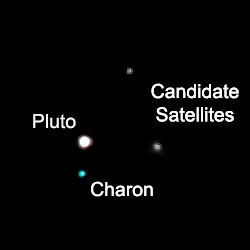
Pluto and its possible new moons. Image credit: Hubble. Click to enlarge.
Using NASA’s Hubble Space Telescope to probe the ninth planet in our solar system, astronomers discovered that Pluto may have not one, but three moons.
If confirmed, the discovery of the two new moons could offer insights into the nature and evolution of the Pluto system, Kuiper Belt Objects with satellite systems, and the early Kuiper Belt. The Kuiper Belt is a vast region of icy, rocky bodies beyond Neptune’s orbit.
“If, as our new Hubble images indicate, Pluto has not one, but two or three moons, it will become the first body in the Kuiper Belt known to have more than one satellite,” said Hal Weaver of the Johns Hopkins Applied Physics Laboratory, Laurel, Md. He is co-leader of the team that made the discovery.
Pluto was discovered in 1930. Charon, Pluto’s only confirmed moon, was discovered by ground-based observers in 1978. The planet resides 3 billion miles from the sun in the heart of the Kuiper Belt.
“Our result suggests that other bodies in the Kuiper Belt may have more than one moon. It also means that planetary scientists will have to take these new moons into account when modeling the formation of the Pluto system,” said Alan Stern of the Southwest Research Institute in Boulder, Colo. Stern is co-leader of the research team.
The candidate moons, provisionally designated S/2005 P1 and S/2005 P2, were observed to be approximately 27,000 miles (44,000 kilometers) away from Pluto. The objects are roughly two to three times as far from Pluto as Charon.
The team plans to make follow-up Hubble observations in February to confirm that the newly discovered objects are truly Pluto’s moons. Only after confirmation will the International Astronomical Union consider names for S/2005 P1 and S/2005 P2.
The Hubble telescope’s Advanced Camera for Surveys observed the two new candidate moons on May 15, 2005. “The new satellite candidates are roughly 5,000 times fainter than Pluto, but they really stood out in these Hubble images,” said Max Mutchler of the Space Telescope Science Institute and the first team member to identify the satellites. Three days later, Hubble looked at Pluto again. The two objects were still there and appeared to be moving in orbit around Pluto.
“A re-examination of Hubble images taken on June 14, 2002 has essentially confirmed the presence of both P1 and P2 near the predicted locations based on the 2005 Hubble observations,” said Marc Buie of Lowell Observatory, Flagstaff, Ariz., another member of the research team.
The team looked long and hard for other potential moons around Pluto. “These Hubble images represent the most sensitive search yet for objects around Pluto,” said team member Andrew Steffl of the Southwest Research Institute, “and it is unlikely that there are any other moons larger than about 10 miles across in the Pluto system.”
The Hubble Space Telescope is a project of international cooperation between NASA and the European Space Agency. The Space Telescope Science Institute in Baltimore conducts Hubble science operations. The Institute is operated for NASA by the Association of Universities for Research in Astronomy, Inc., Washington, under contract with Goddard.
The other team members for this observation are: William J. Merline, John R. Spencer, Eliot Y. Young, and Leslie A. Young, Southwest Research Institute.
Original Source: Hubble News Release
Update: Why isn’t Pluto a planet?
